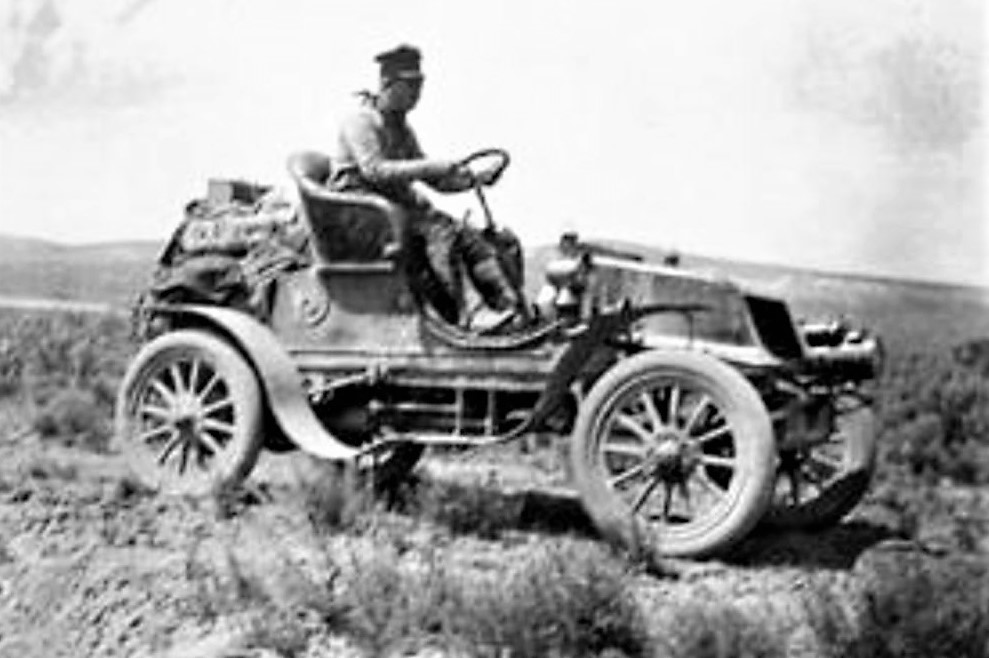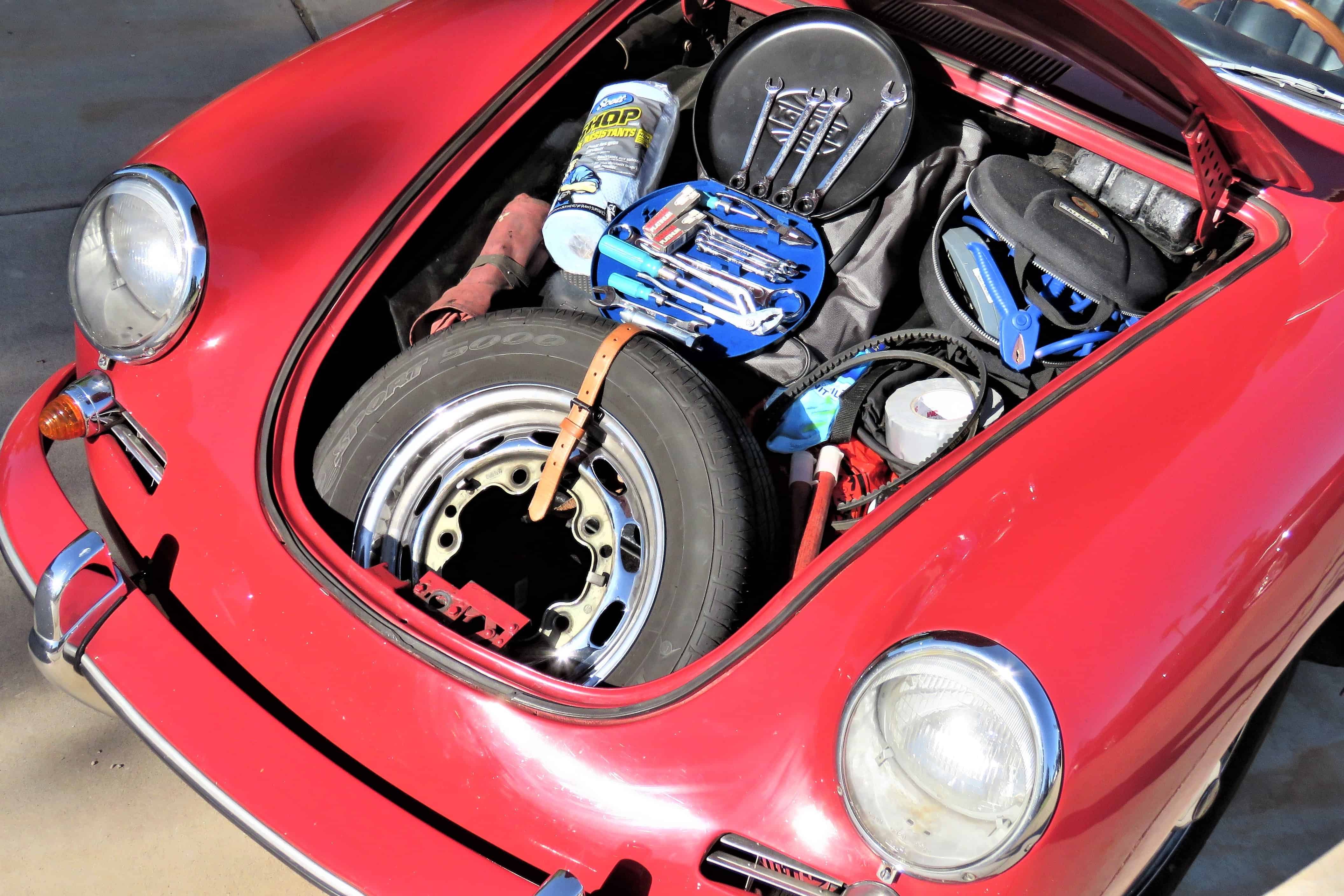Editor’s note: This is the first in a four-part series we’ll be publishing during June to get you ready to take a road trip in your collector vehicle.
Driving an old collector car on a lengthy road trip is always a roll of the dice. No matter how well you take care of your classic, and keep ahead of repairs and replacements, you know that anything can go kablooey at any time, generally in the most remote place possible. It is, after all, an old car.
Broken fan belts, blown hoses, fried ignition points, dead batteries, those are a few of the most-common things that can go wrong. But really, you need to be prepared for anything.
Two times on a cross-country rally in which I participated, cars were laid low by fuel-pump failures. Both were Corvettes, coincidentally, and both of them were restored and well-prepared for the trip. Neither had a spare fuel pump or rebuild kit on board, and neither breakdown occurred anywhere near an auto-parts store.

One day, I was driving my old Porsche 356 when the shift linkage decided to come loose, requiring me to stop on the side of the road and swear my way through a repair. Quite fortuitously, I happened to have with me the two 14mm open-end wrenches that I needed for the fix. So I was able to drive home.
Another time, part of the throttle linkage under the car broke at a connecting link. The repair was made by wrapping it together with duct tape I kept in the trunk. I drove home again.
The lesson here is to be prepared with at least a rudimentary tool kit at all times, even when driving locally. But when heading out on a longer trek of hundreds or even thousands of miles, you need to be mechanically self-sufficient with enough tools, spare parts and other handy stuff to accomplish simple repairs and get back on your way.

There are limitations to what you can tote along; your tool kit and spare parts need to take up as little space as possible so you can also pack your toothbrush and a change of underwear.
Obviously, there are major mechanical breakdowns that can’t be fixed on the road, even if you had the parts. But you shouldn’t let a minor problem ruin your trip just because you weren’t prepared.
Most crucially is what you do before leaving home. You need to make sure every piece on your car is up to snuff, from the battery to the gearbox. Examine everything carefully, and If you have any doubts at all about anything, fix it before you set out.
Carefully check belts and hoses for signs of stress, age or wear, and replace them if you have the least concern. Cheap and easy. If they’re more than a few years old, might as well just change them out.
Tires getting old? Replace them. Starter acting up? Replace it. Front end getting loose or rattling? Have it fixed before hitting the open road. How about that water pump? Brakes are a biggy, so make sure all is in order there, especially checking that all flexible hoses are in good condition, not bulging or oozing.
Check that all fluids are topped up and tire pressures are correct – don’t forget to check the spare. Make sure your jack is in working order and that you have a proper lug wrench.
Once you feel your classic car (or truck) is good to go, here are the items to pack just in case. Now, this would be my personal list of gear, so you might want to add or subtract a few.
My tool kit would include:
• Wrenches in the sizes to fit most components on the car. Duplicates don’t hurt (see shift-linkage repair above). Also a small adjustable wrench just in case.
• Various pliers, such as slip-joint, needle-nose and channel lock.
• A small ratchet wrench, probably quarter inch, and various sockets and extensions. Also have a screwdriver-handle socket tool.
• Screwdrivers, four or five of various types (slotted and Phillips) and sizes.
• A roll of electrical wire and wire cutters. Also crimp connectors and electrical tape. Have one 20- to 25-inch piece of wire with alligator clips or either end for bypassing shorts and such.
• A good wire cutter/stripper/crimping tool.
• A hand-held electronic test gauge.
• Duct tape.
• Zip ties.
• Some bailing wire and maybe a hunk of wire coat hanger for emergency stabilization of such things as a loose exhaust pipe.
• Tire gauge. Also, one of those cans of tire inflator and sealant that work with minor punctures.
• A Swiss Army knife or Leatherman tool.
• Work gloves, hand cleaner and shop towels.
• A small first-aid kit.
You can probably fit all that stuff into a reasonably sized tool bag. Maybe two. Keep it soft-sided for easier packing.
Spare parts you should bring along include:
• Ignition parts, including points, condenser, distributor cap, rotor and spark plugs, maybe not a full set but one or two. Perhaps a spare ignition coil if you have the space and inclination. If your car is from the ’80s or newer, you would have electronic ignition, which does not usually go bad and you won’t need any of this stuff.
• Fan belts, a correct-size spare for each if you have more than one.
• Radiator hoses and clamps, because even if you checked them out, you just never know.
• A few lengths of vacuum hoses in the correct sizes, and a few feet of fuel line.
• A spare fuel pump or rebuild kit. If feasible, you might bring along a small electric fuel pump that you could splice inline, if needed.
• Spare fuses and bulbs.
• Battery jumper cables. You also might get one of those hand-held rechargeable jump-start devices, which work well in most circumstances.
• A bag of extra nuts and bolts.
• A couple of spare wheel lug nuts in case one rolls away into a ditch while you’re changing a tire.
• Any other parts that could be problematic on your specific vehicle.
Other items:
• A fire extinguisher. Keep it inside your vehicle within easy reach.
• Flares or reflective triangles for repairs beside the road. You might get one of those reflective work vests to make yourself more visible.
• A couple quarts of motor oil and a quart of gear oil or automatic transmission fluid, with a means for getting it into the transmission.
• A tow strap. Check under your car to determine where you might attach it instead of groping around when you actually need a tow.
• A gallon jug of water.
Oh, and one other thing: a spare ignition key.
Some items that I missed? Add them in our comments section.






Simple as it may sound, bring an extra set of keys. Back in the 1970s, I ruined a weekend in the Upper Peninsula of Michigan when the ignition key to my 1967 Volvo 22S broke off. Hot-wiring proved ruinous to the car’s under-dash because of the hardened steel cable that was part of Volvo’s theft-proofing approach.
Lots and lots of stuff listed that’s good- but do y’all not check sh** afore ya head out?
My ’04 GTO is not only a GM orphan, but considered an import, being made by Holden of Australia. Everything not directly applicable to the LS1 motor, or Tremec gearbox, is two to ten times more expensive than comparable parts for Camaros, Firebirds, or Cadillac CTS-Vs.
Do I contemplate any road trip, I put my eyes and hands on everything. Sweaty, dirty, greasy, ya, you betcha. Never, NEVER had a road failure, not even a flat, which is completely random and not predictable.
My suggestion? Do you become more familiar with the engineering of your car, and less prone to bitching about it’s perceived failures. Those failures are undoubtedly due to your own lack, not the engineers, designers, nor manufacturers, unless thou defend the Yugo or Pinto. ‘Struth: once you know yon vehicle in an intimate way, you’ll have no surprises. And all your trips will be way mo’ bedda, and tool free.
From a ’66 VW Beetle to the Holden GTO, I have done and do my own maintenance, since 1970.
Trust the guy that is 60 and never used a wrecker- prep, know, and then enjoy.
The only things you didn’t include were an air compressor and an engine hoist.
My ’79 Fiat 124 Spyder wouldn’t have room for all that equipment, even if I left the top down.